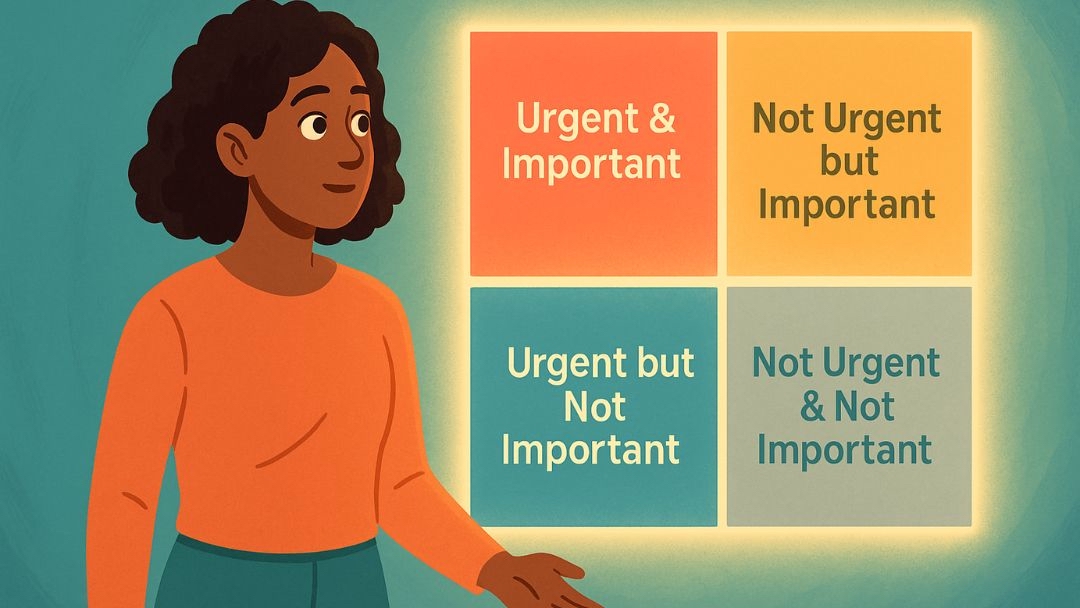The Eisenhower Matrix: What Is It, and How Do I Use It to Become a Time Management Expert?
Staying busy is not the same as being productive. The Eisenhower Matrix can help you understand the difference and teach you to work smart, not hard.


Back
7 mins read
According to a recent study published in the Journal of Consumer Research, humans are hardwired to choose urgent over important tasks. In the study, when presented with both urgent and important tasks, the subjects prioritized the urgent over the important, even though the latter was the objectively better choice.
This psychological quirk, dubbed the “mere urgency effect”, explains why many of us are so bad at prioritization. In time management, it is called the urgency trap, and it is one so many of us unwittingly fall into–prioritizing tasks with a deadline over tasks without, irrespective of the long-term payoffs.
Luckily, the urgency trap is not inescapable. In the study, participants were more likely to choose the important over the urgent when prompted to think about the consequences of their choice.
While you may not always have a friendly researcher to remind you to think about the consequences of your urgent vs. important choice, this article introduces something that works just as well — The Eisenhower Matrix.
With it, you can accurately distinguish between urgent and important tasks, improve your prioritization skills, and get better at time management.
What Is the Eisenhower Matrix?

The Eisenhower Matrix is a simple time management technique that helps you distinguish between important, unimportant, urgent, and non-urgent tasks.
It has many names, such as the Eisenhower Decision Matrix, Time Management Matrix, Eisenhower Box, Eisenhower Method, and the Urgent-Important Matrix. Whatever it’s called, its essence remains the same — a technique for helping you consider the long-term impact of your tasks and thus prioritize better.
You may come across fancier variations of this matrix, but the core idea is very simple — a two-by-two table, each section of which is called a quadrant. The quadrants along the x-axis are labeled Urgent and Not Urgent, while those along the y-axis are labeled Important and Not Important.
The final result is four quadrants with the following combinations: important and urgent; important and not urgent; not important and urgent; not important and not urgent. Each quadrant has its work strategy, which will help you decide what to do with the tasks within it.
Who Created the Eisenhower Matrix?

We’ll get into the usefulness and application of the Eisenhower Matrix in a minute, but first, a little backstory about its creation.
The Eisenhower Matrix was developed by Dwight D. Eisenhower, 34th President of the United States, General in the United States Army, and Supreme Commander of the Allied Forces during World War II.
As you can probably imagine, President Eisenhower was quite a busy guy. Whether as a general, supreme commander, or president, he had to manage several tasks at once and make tough calls on what was important and what wasn’t.
In a speech during his first term as president, he revealed his strategy for juggling so many responsibilities. Quoting an unnamed university president, he said, “I have two kinds of problems, the urgent and the important. The urgent are not important, and the important are never urgent.”
Decades later, author Stephen Covey, in his book 7 Habits of Highly Effective People, cultivated the seeds of the concept planted by President Eisenhower. He developed and popularized what is today known as the Eisenhower Principle, which helps us prioritize tasks by urgency and importance.
If It worked for a president — arguably the most demanding job in existence — you can be certain that it'll work for you.
When Should I Use the Eisenhower Matrix?
The Eisenhower Matrix can help you get better at prioritization, avoid distractions, overcome procrastination, and manage your time better so you feel less stressed. Use it if you:
- are always busy but rarely productive;
- are stagnating in your medium and long-term goals;
- struggle to schedule tasks;
- are a chronic procrastinator; and/or
- struggle to delegate tasks.
Alternatively, since using the Eisenhower Matrix requires you to exercise your time management skills, you can use it as a form of practice to improve the following time management skills:
- Prioritization
- Scheduling
- Delegation
- Saying no
- Avoiding time wasters
The Eisenhower Matrix Explained

When you have a lot of tasks and don't know which to tackle first, you can use the Eisenhower Matrix to set an order of priority. The matrix works by separating tasks into four quadrants using two key criteria: urgency and importance.
The Two Axes of the Eisenhower Matrix — Distinguishing Between Urgent and Important
Urgent and important are familiar words often used synonymously in common parlance. However, these words take on special meaning in the context of the Eisenhower Matrix.
Important tasks are essential to achieving your long-term goals. They may not yield immediate results but contribute to your future growth. They are usually strategic, requiring careful planning and foresight. Conversely, unimportant tasks are those with no connection to your long-term goals. They are mundane, routine, and usually easy to do.
Urgent tasks, on the other hand, require your attention now. They usually have pressing deadlines or immediate consequences if they are not done. Non-urgent tasks are the exact opposite. They either have far-away deadlines or are open-ended.
The distinction between important and urgent tasks can sometimes be murky in real-world situations. Therefore, you must have a clear understanding of what they mean.

The Eisenhower Quadrants
Each quadrant in the Eisenhower Matrix has its own work strategy for dealing with tasks. Depending on where tasks fall, you will do, decide, delegate, or delete them.
Quadrant 1 — Do It (Top Left)
Tasks that fall into this quadrant are important and urgent; therefore, they must be done quickly. Examples are:
- Fixing a bug, you discovered in your software a day before launch.
- Handling a presentation on behalf of a colleague who’s out sick.
- Writing up a report that’s due the next day.
When doing tasks in this quadrant, you are reactive and in crisis management mode. Try not to spend too much time here because doing so can trap you in a vicious cycle where you’re always putting out fires with little time to plan the tasks that actually contribute to your long-term goals.
Spending too much time in crisis management mode can also increase your stress and cause burnout.
Quadrant 2 — Decide and Schedule It (Top Right)
The second quadrant is arguably the most important for time management. It houses tasks that, while important, are not urgent, so you can decide when to do them and schedule them for later.
Examples are:
- Taking an online course to improve your skill
- Networking with professionals in your field
- Updating your resume
If in quadrant one you are reactionary, quadrant two requires you to be proactive. Here, you focus not on immediate results but on growth and your future prospects.
You should endeavor to keep most of your tasks in this quadrant. Ideally, you can chip away at them early enough that they never become urgent and migrate to quadrant 1.
Quadrant 3 — Delegate It (Bottom Left)
This quadrant houses what we call busy work, less important but urgent tasks that you are better off passing on to others.
Examples include:
- Unnecessary meetings
- Writing and replying to emails
- Bureaucratic processes
Since these tasks don't need your specific skill set, you can delegate them to your team instead of letting them eat up your time.
Quadrant 4 — Delete It (Bottom right)
After the first three quadrants, the tasks left over automatically fall into the last quadrant. These tasks are neither important nor urgent and should not even make your to-do list. Delete them.
Examples include:
- Binge-watching television shows
- Checking social media
- Mindlessly scrolling the internet
How to Use the Eisenhower Matrix — Step-By-Step Guide

Before applying the Eisenhower method and putting tasks into the appropriate quadrant, the first thing you need to do is create a list that includes your immediate “to-do’s”, your routine and usual tasks, short-term and long-term tasks, as well as the things you do regularly that may not be productive towards reaching your goals. Be honest!
You can create a list for work and one for home, one for just work, or you can create a combination list if that works better for you. If you work remotely or for yourself and find it difficult to keep work and personal tasks from interfering with each other, it is critical for you to work towards a way to keep them separate.
- Carefully think about each task and put each one of the four quadrants of the Eisenhower Matrix.
- Delete all tasks in the fourth quadrant.
- Delegate all tasks in the 3rd quadrant.
- Rearrange your to-do list with the first quadrant tasks first and the second quadrant tasks next.
Become a Better Time Manager with the Eisenhower Matrix
As we previously mentioned, the second quadrant is where your goal-oriented tasks live. If most of your tasks fall within it, congratulations, you are an excellent time manager. However, if most of your tasks are in any of the other four quadrants, you need to rebalance your matrix.
You can do that by:
- Doing a time audit. Track your time and tasks for a week and analyze how you spend it using the Eisenhower Matrix.
- Investing time in planning. If your analysis reveals that you spend the majority of your time doing Q1 tasks, it means you need to be more intentional in your planning. Schedule periodic planning sessions, review how you spend your time, and look for ways to improve.
- Creating a delegation strategy. If your time spent is skewed toward Q3 tasks, it means you need to work on your delegation skills. Develop a structured strategy for delegation and refine it with every application until you are satisfied.
- Identifying your time wasters and procrastination triggers. If the majority of your tasks live in the fourth quadrant, you are easily distracted or a chronic procrastinator. Identify your triggers, whether a fear of failure or an inability to say “no,” and develop a plan to overcome them.
Tips for Using the Eisenhower Matrix
The Eisenhower Matrix is a simple tool that can transform your time management strategy. Here are a few tips to help you make the most of it:
- Maintain a singular list for both your personal and professional life. That way, neither suffers.
- Don't overload your quadrants. Try to limit yourself to a maximum of 10 tasks per quadrant.
- After prioritizing your to-do list with the Eisenhower Matrix, color code it to make it easier to visualize.
- Time block according to quadrant. For example, you can do the first quadrant tasks in the morning when you are feeling at your best and the fourth quadrant tasks at the close of the day.
Try Out the Eisenhower Matrix

Like President Eisenhower, you too can become productive and not merely busy. The Eisenhower Matrix is vital for that. It can help you distinguish between important and urgent tasks and consequently channel your energies in the right direction. Give it a spin and watch your efficiency skyrocket in no time.
To help you out, BrainManager has created a blank Eisenhower Matrix you can print out. You can find it in the member’s area, or simply click the link below.
Use the Eisenhower Method for Effective Time Management
Demi Adejola
Content writer
Published 31 October 2022



